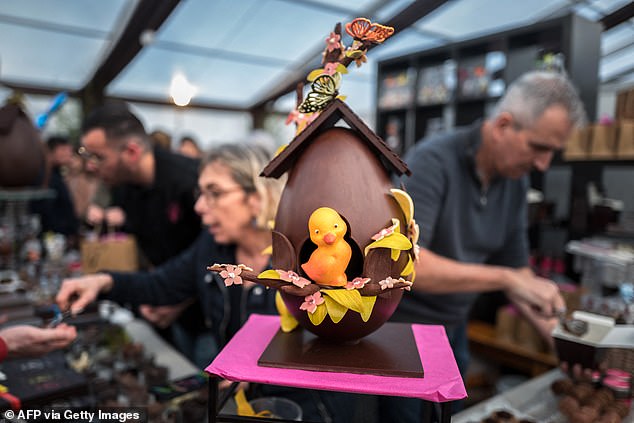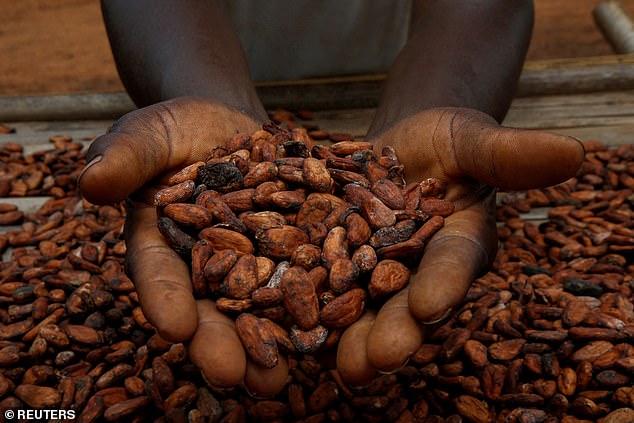Table of Contents
Brits who broke Lent with their favorite chocolate Easter egg may have had a rude awakening when they hit the supermarket.
Cocoa, the key ingredient in chocolate, has seen its value rise to more than $10,000 per tonne by 2024, up from less than a quarter of that value early last year.
The once relatively niche product in the investment world is now poised to continue its dramatic rise, with a cocktail of growing demand and shrinking production capacity putting further pressure on consumers.

More expensive: a study by consumer website Which? found that many popular Easter eggs were at least 50 percent more expensive than at the same time last year
A study by consumer website Which? discovered that many popular Easter eggs were at least 50 percent more expensive than last year around the same time.
Tesco sold the Ferrero Rocher Golden Easter Egg for £15 instead of £10 and a Thorntons Milk Chocolate Dinosaur Egg for £4.50 instead of £3, while a Maltesers Truffles Luxury Easter Egg was 62.5 per cent more expensive at Waitrose.
Other delicacies have fallen victim to ‘shrinkflation’; the Twix Milk Chocolate and Terry’s Chocolate Orange with Mini Eggs Easter eggs cost the same at Tesco as last year, but now weigh 200 grams, not 246 grams and 230 grams respectively.
The increase is not necessarily the result of greedy confectionery manufacturers, but of rising cocoa prices, which reached just $10,000 per tonne for the first time in history.
By comparison, prices stood at $2,535 per tonne in January 2023 – about a quarter of their current levels – and $4,196 per tonne at the start of this year.
What’s behind the huge rise in cocoa prices?
Most of the world’s cocoa comes from two countries: Ghana and Ivory Coast, which together provide about 60 percent of the world’s supply.
The two West African countries’ output has been undermined by a perfect storm of factors that have contributed to plummeting production volumes.
Heavy rains due to the El Nino phenomenon have led to poor road conditions and spread the swollen shoot virus and black pod disease, infecting a large portion of cocoa trees.
These cacao trees are typically quite mature in age – 20 to 25 years old – meaning they are well past their production years and more vulnerable to disease.
Farmers are supposed to plant new trees to ensure stable production levels, but this has not happened on a large scale in West Africa since the early 2000s.
“Taking into account that it takes six years to grow a mature fruit-bearing cocoa tree, the market is preparing for the fourth consecutive year of crop shortages, and this resulting supply shock is sending cocoa prices higher,” notes Jeneiv Shah . manager of the Sarasin Food & Agriculture Opportunities fund.
Many farmers also earn so little that they cannot afford to replace trees; the average cocoa farmer in Ivory Coast receives just $1.23 per day, according to estimates from Dutch confectionery manufacturer Tony’s Chocolonely.
And even if they were paid fairly, the amount of land available for cocoa farming has shrunk, a problem exacerbated by illegal miners buying up cocoa plantations.


Rising: Global cocoa prices recently reached $10,000 per tonne for the first time ever
In addition, Ukraine’s large-scale invasion of Ukraine has caused fertilizer prices to skyrocket and prompted many farmers to reduce their fertilizer use.
According to the International Cocoa Organization (ICCO), cocoa arrivals at the ports of Ghana and Ivory Coast have fallen by 28 percent and 35 percent respectively since last season.
The ICCO predicts that the global cocoa market will face a supply shortage of 374,000 tonnes in the 2023/2024 season, compared to 74,000 tonnes the year before, and that total production will fall by 11 percent to 4.5 megatonnes.
What does this mean for chocolate prices?
Rising cocoa prices have forced many chocolate makers to raise prices for their products, whether Easter eggs or regular chocolate bars, to offset higher ingredient costs.
Lindor owner Lindt & Sprungli, whose goods usually contain a high proportion of cocoa, increased the price of many products last year, including its popular gold foil-wrapped Easter bunnies.
The measures helped increase organic sales by 10.3 percent to $6.06 billion in 2023 and net income by 17.9 percent to $758 million.
In the same year, Cadbury’s parent company, Mondelez, implemented double-digit price increases in Europe and Latin America, including 31 percent in the latter area.
Price increases drove the vast majority of the group’s revenue growth, which grew 14.4 percent to more than $36 billion and helped boost net profit to almost $5 billion.
The US company, whose products also include Toblerone and Belvita biscuits, plans further price increases in 2024, even as it expects some backlash from customers in Europe.
Still, the company, like many other chocolate manufacturers, expects a weaker performance this year, with organic sales growing only 3 to 5 percent.
Meanwhile, Hershey forecasts a net sales decline of 2 to 3 percent due to soaring cocoa and sugar prices, the latter of which have also risen by about a quarter in the past year.
Chocolate makers can only charge so much before customers flock to alternative products.
Any attempt to sell smaller versions of the same product at a similar price could have the opposite effect: Toblerone faced massive criticism when it changed the weight and shape of its bar in 2016, only to reverse course two years later.
“Bars have already been hit by contraction inflation, and shoppers won’t be impressed by another Willy Wonka-style disappearing act,” said Susannah Streeter, head of money and markets at investment platform Hargreaves Lansdown.
Will cocoa prices continue to rise?
Unfortunately, it appears that cocoa prices will continue to rise for the foreseeable future as supply fails to keep pace with growing consumer demand for chocolate.
Part of the reason stems from the way the cocoa market is regulated: Ghana and Ivory Coast set “farm prices” once or twice a year to protect farmers from very low prices.
However, it means that farmers do not benefit when prices rise, giving them little incentive to expand production in the short term. Paying more would be an obvious solution.
Tony’s Chocolonely, whose founder started the company after realizing that so much chocolate production was linked to slave labor, developed the Living Income Reference Price in partnership with Fairtrade International to ensure what farmers earned reflected the local cost of living.
It believes that cocoa farmers in Ghana should earn $1.96 per person per day, while those in Ivory Coast should be paid $2.45 per day.
But even if this were to happen, farmers would still face the threats of disease, climate change and chronic underinvestment that plague the cocoa sector.
Chocolate makers are also buying a lot of cocoa in advance, notes Sarasin’s Jeneiv Shah, who warns that more price increases are in store.
“There has been some impact on current chocolate prices on shelves, but it will be 2025 when consumers will see higher prices for chocolate bars and products,” he says.
Shah further warns that “there are no immediate public options” for those who want to benefit from skyrocketing cocoa prices.
He said the price hike is “more of a very small headwind for certain FMCG (fast-moving consumer goods) companies rather than an opportunity to gain investment returns.”
Some links in this article may be affiliate links. If you click on it, we may earn a small commission. That helps us fund This Is Money and keep it free to use. We do not write articles to promote products. We do not allow a commercial relationship to compromise our editorial independence.


